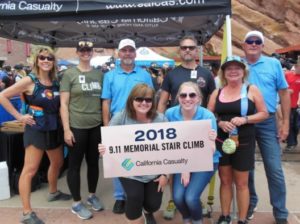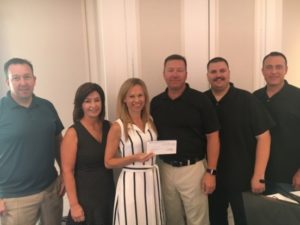by California Casualty | Auto Insurance Info |
Icy roads. Traffic jams. Black ice. Snow conditions. All of these can make a parent go crazy just thinking about their teen driving in these conditions. How do you talk to your new driver about driving in the winter season? We have some easy tips to get the conversation going.
- Decrease your speed. The faster you’re going, the more room you’ll need to stop.
- Be extra careful on bridges and overpasses.
- Avoid cruise control or overdrive.
- Don’t pass snow plows – their drivers may not see you, and the roads are clearer behind them anyway!
- Turn on your lights to be more visible.
- Steer into a skid – this means if your rear wheels are going right, gently steer in that direction.
- Gently tap your brakes, if you have ABS brakes, gently apply constant pressure.
- Keep your windshield wiper fluid filled and keep your headlights clean.
These helpful ideas do not have to just be for your teen. Share with friends and family.

by California Casualty | Educators |
Our Education Blogger is a public school teacher with over a decade of experience. She’s an active NEA member and enjoys writing about her experiences in the classroom.
Your personal life is yours, and it is precious. It is also necessary. Especially during winter break. There is no need to feel guilty about leaving work behind each day when you exit your classroom door. Enjoying your time outside of school makes you a better teacher. Relationships with students, parents, and colleagues may also improve when you maintain a balance between work and home. Over the years, I have learned, but not yet quite mastered, several ways to create a balance between my work life and home life.
Don’t Give Out Your Personal Information To Parents or Students
If you must communicate with parents and students outside of the school day, sign up for a social media account you can use for your classroom. Don’t give out your personal phone number, email address, or home address. Many parents and students are able to set respectful boundaries. However, there may be some parents or students who will abuse this communication privilege. This can sour your relationship with a parent or student if they continue to overuse your attempt to be “available.” You don’t want to find yourself in a sticky situation that could get you into trouble.
Keep Work At Work
Leave all of your grading and planning at school. Home should be your sanctuary, not a second office. Your family, pets, and brain will thank you for it.
Maintain Consistent Work/Office Hours
Try to arrive and leave at the same time each day. Make sure parents, students, and colleagues are aware of your daily “office hours.” Each day, I make a point to arrive no later than 7:15am and leave no later than 4:30pm. My “office hours” are 7:30-7:50am and 3:15-4:00pm. If a parent or student needs to meet with me, they know when I will be available.
Enjoy Family Time
Savor each moment you have with your own family. I love my job, and I adore my students, but I refuse to sacrifice precious time with my own family. I can never get that special time back. Grading papers, planning lessons, and returning emails can wait until the next day. So, file away those tender memories with your family without the guilt.
Protect Your Personal Social Media Accounts
Being “friends” on your personal social media with students and parents is not required. I am protective of myself and my family, so I stick to a few of my own rules for my personal social media account:
1) never be friends with a current student
2) students must be at least 13 years old (most social media services and apps require users to be 13 years old to join)
3) never be friends with a current student’s parent(s) or other family members
4) keep profile set to private
Social media can bring with it negative talk, upset feelings, and online bullying. I have no desire to get myself, or my family, involved in anything of the sort.
Don’t Check Work Email At Home
I review my work email on my school computer throughout the day, and in the moments before I shut the computer down to leave for the day. Then, I don’t check it until I arrive at school the following day. I used to have my work email synced to my personal cell phone. Big mistake. I found myself getting emotionally worked up at home about the occasional negative email from a parent or colleague. When there were “security” threats to our district email system (mostly viruses), my personal phone, along with all of my personal accounts, were at risk. Forget about sleeping when all I can think about is how I’m going to respond to the angry parent, or wondering if my phone would be affected because of a naive colleague who opened an email attachment from an unknown sender! Ditching my access to work email from home has significantly lowered my stress level (and I’ve even gotten a few more zzzz’s)!
Recruit Help
It’s okay to ask for help. Get a neighbor, a friend, a babysitter, or a grandparent to help you out at home if you need it. You aren’t superhuman! We all need a little extra support from time to time.
Be Realistic
Be realistic about what you can and can’t do. There may be nights that you won’t be able to cook dinner. That’s what delivery and take-out are for! It’s okay to bring a frozen, microwave meal for lunch (although that 5-minute cook time really eats into my lunch time). I promise, no one will judge you! Yes, it’s okay for dirty laundry to sit around in the hamper for a few days. You’ll get to it when you can.
Be Disciplined
Stick to it and mean it. If you crave more personal time, then be picky about your work hours, how you spend your time outside of school, and choosing to leave work at work. If you don’t think you can be disciplined, ask someone to help you by holding you accountable. Your partner or spouse can make sure you’re not checking work email, or bringing home papers to grade. Your best friend can check in on you to see if you’re keeping the right company on social media.
We’d love to hear from you! How do you create a balance between work and home?
This article is furnished by California Casualty, providing auto and home insurance to educators, law enforcement officers, firefighters and nurses. Get a quote at 1.866.704.8614 or www.calcas.com.
by California Casualty | Calcas Connection, In Your Community |
In these trying times, it’s an honor to work with so many who give so much for our communities. California Casualty appreciates all that you do, and our employees and executives are proud to be a part of your everyday lives. From disaster relief to prize giveaways, we are dedicated to making a positive impact for you, your peers and your families.
 Knowing the toll the California fires took on the people that we insure, the California Casualty Cares Committee of the Advisory Board wanted to assist the many heroes who helped others at their own peril. California Casualty donated $20,000 to the CTA Disaster Relief Fund to help CTA members who have experienced significant losses due to the disasters in California.
Knowing the toll the California fires took on the people that we insure, the California Casualty Cares Committee of the Advisory Board wanted to assist the many heroes who helped others at their own peril. California Casualty donated $20,000 to the CTA Disaster Relief Fund to help CTA members who have experienced significant losses due to the disasters in California.
California Casualty is also working with other groups, such as the Police Officers Research Association of California, California Association of Highway Patrolmen, California State University System, and the California State Firefighters’ Association, to give an additional $12,000 in donations from the Cares Committee. These donations supplemented $7,500 given earlier in the year to help with the 2017 fires that struck Sonoma and Ventura Counties.
In an effort to remind insureds to check their policies and make sure they have enough coverage to protect against a disaster, California Casualty initiated “Wherever Your Journey Takes You…We’ll be There” Sweepstakes. Bloomingdale, Illinois 8th grade teacher Kathleen Nikides was the grand prize winner. She was surprised with the $25,000 award November 16 during an assembly at Stratford Middle School.

“I’m still flying high, I can’t believe I won. My husband and I will take some time to figure out what we will do with the money,” she said.
Kathleen found out about the contest from the Illinois Education Association, but never thought she’d win.
Teaching for 35 years, 30 years at Stratford, Kathleen loves advocating for students and helping them reach their full potential. “I always knew I wanted to be a teacher, and I still love every minute of it. It was great that my students were so excited when they learned that I had won.”
Kathleen is the co-president of the Carol Stream Education Association, which is an affiliate of the Illinois Education Association, and is thankful California Casualty supports education associations. “Thanks to member benefit partners like California Casualty, we feel valued, and that value is very appreciated right now,” she said.
More than 52,000 school administrators, instructors and education support professionals shared their journey and entered the contest.
Knowing how hard firefighters, law enforcement officers and EMTs work, and the danger they put themselves in to keep us safe, California Casualty invited first responders to sign up for the “Better Safe Than Sorry” Work Hard/Play Hard contest. Three winners – in California, Colorado and Oregon – will each be receiving a check for $2,250, to purchase the Liberty Safe of their choice, that they can fill with a collection of provided 5.11 tactical gear – a total prize value of $2,950. We’ll share who the winners are in the next California Casualty Connection.
 In an effort to reduce tragic driving deaths and injuries, a total of $12,000 was recently awarded in the Fall Create Real Impact contest, sponsored by California Casualty and Impact Teen Drivers. The Create Real Impact contest encourages the creative efforts of youth ages 14-22 to prevent distracted driving – the number one killer of teens in the U.S.
In an effort to reduce tragic driving deaths and injuries, a total of $12,000 was recently awarded in the Fall Create Real Impact contest, sponsored by California Casualty and Impact Teen Drivers. The Create Real Impact contest encourages the creative efforts of youth ages 14-22 to prevent distracted driving – the number one killer of teens in the U.S.
Grand prizes were awarded for best video, writing, music and art submissions, and to schools that had the most entries. Create Real Impact is one of the many initiatives employed by Impact Teen Drivers to combat dangerous inattentive driving. Your kids, or students at your school, can learn more and enter the 2019 spring contest at www.createrealimpact.com.
TAKEAWAY: Learn more about California Casualty’s commitment to the groups we serve at https://mycalcas.com/community/, and share your pictures and stories about the men and women who make a difference for our communities at our Facebook page, www.facebook.com/CaliforniaCasualty.
by California Casualty | Calcas Connection, In Your Community |

California Casualty’s 9/11 Red Rocks Stair Climb Team
It’s hard to describe the emotions of being part of the thousands who turned out to honor first responders on the 17th anniversary of the 9/11 attack in New York. If you were lucky enough to be a participant, you know the mix of sadness, pride, and amazement that comes with each step at one of the many stair climbs held across the country. California Casualty helped sponsor a half-dozen memorial climbs, from California to Colorado and Ohio to Maryland.
We were honored to join firefighters, EMTs, law enforcement officers and medical professionals to remember the heroes who gave their lives to save others, and to support the National Fallen Firefighters Foundation and its mission of providing emotional and financial help to the families of fallen firefighters. Students and teachers from various schools also attended, learning about the terrible events that day.

California Casualty’s Debbie Harris and Lorelei Seip at the Yellow Springs, OH, Stair Climb
Miami Township Fire-Rescue Chief, Colin Altman, who organized the 150-person climb in Yellow Springs, Ohio, was grateful for California Casualty’s help and presence. “Your field team not only provided snacks and bottled water, but they were supportive and wonderful, making a difference cheering people on,” he said. Chief Altman feels it’s important to teach young people who were born after 2001 about the impact of that day, and not to forget the heroism exhibited by first responders.
California Casualty feels a responsibility to the brave men and women who risk their lives to make our communities safer every day. Following another disastrous California fire season, in early September we donated $2,500 to the Peace Officers Research Association of California (PORAC) Police Officers Relief and Education Foundation’s Wildfire Relief Fund. The fund assists law enforcement members whose homes were damaged or destroyed by wildfire, often while they were working to protect others during the firestorm.

California Casualty’s Jana Charles and Roxanne Dean presenting a donation to PORAC Insurance Benefits Trustees
And in May, California Casualty also had the privilege of participating in two important law enforcement memorial weekends. CEO Beau Brown and Vice President for Account Relations Roxanne Dean attended the California Police Officers’ Memorial Ceremony in Sacramento, commemorating six officers who died in the line of duty in 2017. California Casualty provided the blue light pens used at the evening candlelight ceremony, and is a donor to the California Police Officers’ Memorial Foundation scholarship fund, which aids the families of fallen officers. Roxanne is also an advisor to the Memorial Foundation Board and sits on the Fundraising Committee.
Roxanne and Account Relations Manager Alina Fayerman represented California Casualty at the 2018 National Law Enforcement Officers Memorial and the National Association of Police Organization’s TOP COP Awards, held in the Nation’s Capital. The TOP COP Awards highlight the heroic actions of law enforcers and honors those who lost their lives in the line of duty. While everyone who attended felt moved by the events, Alina summed it up best: “It struck me that our protectors need protecting and their families need our love and support.”

California Casualty has partnered with law enforcement associations for almost 50 years and firefighter organizations for 45 years, and we appreciate their service and sacrifices.
TAKEAWAY:
Learn more about California Casualty’s commitment to first responders at https://mycalcas.com, and share your pictures and stories about the men and women who wear a badge at our Facebook page, www.facebook.com/CaliforniaCasualty.
by California Casualty | Calcas Connection, In Your Community |
It’s been quite a year for educators. California Casualty is glad to celebrate the progress made despite challenging times.
Once again, we had a great opportunity to meet with the delegates at the annual NEA Representative Assembly (NEA RA), held this July in Minneapolis, and explain the benefits of the NEA Auto & Home Insurance Program provided by California Casualty.
 Gathering with 6,000 representatives from around the country is always inspiring. The passion for students and public schools always impresses us. It’s wonderful to reconnect with old friends (many of whom are longtime policyholders) and get introduced to new ones, sharing the importance of membership to an organization like the NEA that fights for the rights of teachers and education support professionals.
Gathering with 6,000 representatives from around the country is always inspiring. The passion for students and public schools always impresses us. It’s wonderful to reconnect with old friends (many of whom are longtime policyholders) and get introduced to new ones, sharing the importance of membership to an organization like the NEA that fights for the rights of teachers and education support professionals.
Brian Goodman, Assistant Vice President of Field Relations, was working feverishly to catch up with as many NEA members as he could. “The NEA RA is really a remarkable event. It is rewarding to see our genuine leadership connections from across the country and get a chance to interact with 6,000 NEA leaders at one location,” he said.
California Casualty Senior Vice President Doug Goldberg concurs. “This year, the passion and energy at the RA was palpable, understandably with all of the external pressures facing public education,” he said.
Assistant Vice President Lisa Almeida added, “In my 13 years attending the Assembly, this was the best ever. Meeting with NEA leaders from across the country and hearing about their positive interactions with California Casualty and their local Field Marketing Managers is so gratifying.”
Doug said that NEA members took notice of the value and attention they receive from California Casualty. “We learned over handshakes and hugs with our friends and customers how much they appreciate the NEA, NEA Member Benefits and partners like California Casualty. In one example, a past NEA president sought us out to say he’d be switching over soon. The presidents of a couple states’ two largest locals also came to thank us for our local representation.”

Field Relations Vice President Debbie Harris summed it up with, “We often hear praise from delegates about our local reps from their states. They see us as friends and partners. Those relationships are priceless.”
TAKEAWAY:
We love hearing your California Casualty stories. Share them at our Facebook page, www.facebook.com/CaliforniaCasualty, or tell your colleagues and family about our exceptional service and have them visit www.calcas.com to learn more about what we do and how we serve you.









 Gathering with 6,000 representatives from around the country is always inspiring. The passion for students and public schools always impresses us. It’s wonderful to reconnect with old friends (many of whom are longtime policyholders) and get introduced to new ones, sharing the importance of membership to an organization like the NEA that fights for the rights of teachers and education support professionals.
Gathering with 6,000 representatives from around the country is always inspiring. The passion for students and public schools always impresses us. It’s wonderful to reconnect with old friends (many of whom are longtime policyholders) and get introduced to new ones, sharing the importance of membership to an organization like the NEA that fights for the rights of teachers and education support professionals.